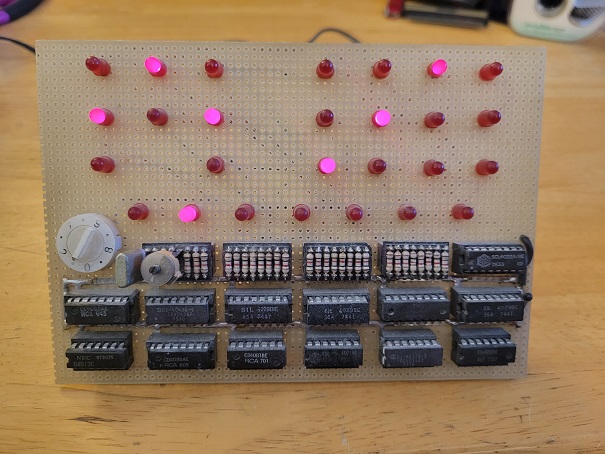My Binary Clock
December 5, 2022
New York, N.Y.
While wandering in some store around 1980 or so, I saw a clock that displayed the time using flashing lights. It didn’t take long to establish that the lights were binary representations of the digits of the time. The lights were behind smoked glass, so it looked rather nice, and of course it was exotic and futuristic. The price was set accordingly, which I thought was outrageous considering the simplicity of the circuitry.
Because I was deeply immersed in digital logic at the time, I decided to make my own no-frills binary clock without anything hiding the circuity. I think I built a couple of them. The only one I know that still exists was displayed proudly in my mother’s house for many years (usually with the incorrect time) and then moved to our little house in the Catskills (where it sometimes displays the correct time):
Reading from bottom to top, the time is Monday, 8:54:22 AM.
Here’s a little video of me discussing the clock, how to tell the time, and how to set the time:
In 1998, I built a couple more BCD clocks for friends. I didn’t have the original circuit diagram, so I redesigned it, and my sketch of that circuit recently turned up. It’s labeled January 1998 and was in three pages held together with a rusty paperclip. Here is the complete horizontally scrollable circuit diagram patched together from the three pages:

The CMOS chips used in this circuit are referenced with their numbers:
4013: Dual D Flip-Flop
4017: Decade Counter/Divider with 10 Decoded Outputs
4020: 14-Stage Ripple-Carry Binary Counter/Divider
4071: Quad 2-Input OR Gate
4078: 8-Input OR Gate
4081: Quad 2-Input AND Gate
4518: Dual Synchronous Up Counter
The little numbers outside the boxes are pin numbers used for wire-wrapping.
The mechanism to set the correct time is considerably simpler than in Version 1. It involves a little jumper (at bottom left) that you insert at midnight when Saturday changes to Sunday. I made a little modification for a friend who wasn’t usually up at midnight so she could set insert the jumper at noon on Sunday.
When I was working on the 2nd edition of my book Code: The Hidden Language of Computer Hardware and Software, I decided to devote a whole chapter to digital clocks beginning with a virtual version of the BCD clock, and I came up with an even better solution. You can check it out in Chapter 18 of the book, or play around with a graphical simulation free of charge on the Chapter 18 page of the companion website.
